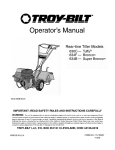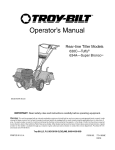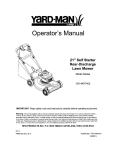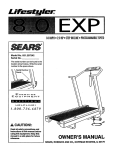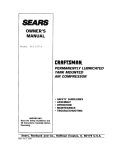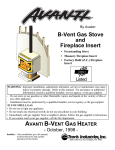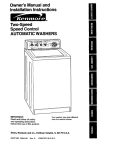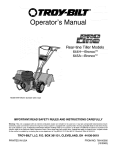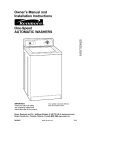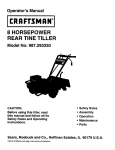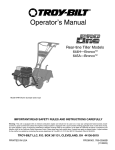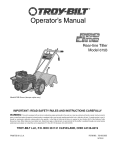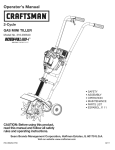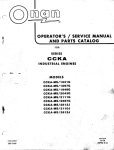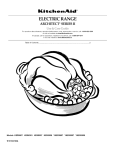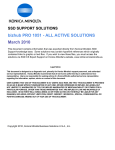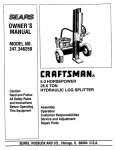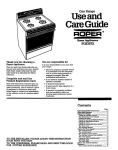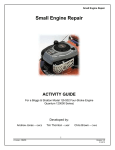Download Troy-Bilt 634BM Tiller User Manual
Transcript
O TRO_ BILT
Operator's Manual
Rear-tine Tiller Models
630C
634Fm
634Bm
Tuffy_
BroncoTM
Super BroncoTM
Model 634B Shown
IMPORTANT:
WARNING:
READ SAFETY RULES AND INSTRUCTIONS
This unit is equipped with an internal combustion
CAREFULLY
engine and should not be used on or near any unimproved
forest-
covered, brush-covered or grass-covered land unless the engine's exhaust system is equipped with a spark arrester meeting applicable
local or state laws (if any). If a spark arrester is used, it should be maintained in effective working order by the operator. In the State of
California the above is required by law (Section 4442 of the California Public Resources Code). Other states may have similar laws.
Federal laws apply on federal lands. A spark arrester for the muffler is available through your nearest engine authorized service dealer or
contact the service department, P.O. Box 361131 Cleveland, Ohio 44136-0019.
TROY-BILT
PRINTEDIN U.S.A.
LLC, P.O. BOX 361131 CLEVELAND,
OHIO 44136-0019
FORM NO. 770-10594C
11/25/02
TABLEOFCONTENTS
Content
Page
Calling Customer Support .......................................................................................................2
Safety......................................................................................................................................3
Assembly................................................................................................................................6
Freaturesand Controls ............................................................................................................lg
Operation................................................................................................................................12
Maintenance...........................................................................................................................17
Off-SeasonStorage.................................................................................................................21
Troubleshooting......................................................................................................................22
Parts List ................................................................................................................................23
Warranty Information ..............................................................................................................Back Cover
FINDINGMODELNUMBER
This Operator's Manual is an important partof your new Rear-tine Tiller. It will help you assemble, prepareand maintain the unit for
best performance. Pleaseread and understand what it says.
information from it in the space providedbelow. This information is very importantif you need help from our Customer
Beforeyou
start assemblingyour
new
equipment,pleaselocate the model plateon the equipment and copy the
Support Department
or an authorized
dealer.
You can locate the model number by looking on the rear surface of the tine shield. A sample model plate is explainedbelow. For
future reference, pleasecopy the model number and the serial number of the equipment in the space below.
Copythe model numberhere:
O TRII_BILT
www.troybilt.com
•
Copythe serial numberhere:
• _."__-_ _. _
CLEVELAND,
OH44136
330-558-7220
866-840-648_
ENGINEINFORMATION
Theengine manufacturer is responsiblefor all engine-related issueswith regard to performance, power-rating, specifications,
warranty and service. Pleaserefer to the engine manufacturer's Owner's/Operator's Manual packed separatelywith your unit for more
information.
CALLINGCUSTOMERSUPPORT
If you have difficulty assemblingthis product or have any questions regarding the controls, operation or maintenanceof this unit,
pleasecall the Customer Support Department.
Call1- (330) 558-7228 or 1- (866) 848-6483 to reacha Customer Support representative.Pleasehaveyour unit's
model number and serial number readywhen you call. See previous section to locate this information. You will be
askedto enter the serial
SECTION1: SAFETY
This machinemeetsvoluntarysafetystandardB71.8-1996, whichis sponsoredbythe
OutdoorPowerEquipmentInstitute, Inc.,
and is publishedbythe AmericanNational
StandardsInstitute.
ForwardClutchB_
ReverseClutchControl
(Models634F/634B)
WARNING
Depth Regulator
The engine exhaust from this productcontains
chemicals known to the State of California to
cause cancer, birth defects or other reproduc-
/
Tine HoodFlap
SafetyAlert Symbol
in thisis manual
the unit Ittoisalert
This
a safetyand
alertonsymbol.
used
you to potential hazards. When you
see this symbol, read and obey the
message that follows it. Failu re to obey
safety
messages could result in
persona t injury or property damage.
1. Carefully readthis OwnTraining
er's Manual. the separate
Engine Owner's Manual
and any other literature you may receive.
Be thoroughly familiar with the controls
and the proper use of the tiller and its engine. Know how to stop the unit and dlsengage the controls quickly.
2. Neverallow children to operatethe tiller.
Never allow adults to operatethe tiller
without proper instruction.
3. Keep the area of operation clear of all
persons, particularly children and pets
4. Keep in mind that the operator or user is
responsible for accidents or hazards occurring to other people,their property,and
themselves.
Preparation
1. Thoroughly inspect the area where the
tiller is to be used and remove all foreign
objects.
2. Be sure all tiller controls are released
and both wheels are in the Wheel Drive position before starting the engine.
(SRT)
Figure1-1: Tillerfeaturesandcontrols.SeeseparateEngineOwner'sManualto
identifyenginecontrols.
3. Do not operatethe tiller without wearing
adequateouter garments. Avoid loosegarments or jewelry that could get caught in
moving parts.
4. Do not operatethe tiller when barefoot
or wearing sandals,sneakers, or light footwear. Wear protective footwear that wi
improve footing on slippery surfaces.
5. Do not till near underground electric cables. telephone lines, pipes or hoses. If in
doubt contact your telephone or utility
company.
6. Warning: Handlefuel with care: it is
highly flammable and its vapors are explosive. Takethe following precautions:
a. Store fuel in containers specifically
desLgnedfor this 3urpose.
I]. Thegascapshallneverbe removedor
fueladdedwhiletheengineis running.
Allow the engineto coolfor several
m_nutesbeforeadding fuel.
#. Keep matches, cigarettes, cigars,
ptpes, openflames and sparksaway
from the fuel tank and fuel container.
d. Fill fuel tank outdoors with extreme
care. Never fill fuel tank indoors. Use
a funnel or spou[ to preventspillage.
e. Replaceall fuel tank and container
caps securely.
f. If fuel is spilled, do not attempt to
start the engine, but move the machine away from the area of sp_llage
and avoid creating any source of iglit{on until fuel vapors havedissipated.
7. Nevermake adjustments when engine _s
running {unless recommended oy manufacturer).
Operation
1. Do not put hands or feet near or under
rotating parts
2. Exerciseextreme caution when on or
crossing gravel drives, walks, or roads.
Stay alert for hidden hazardsor traffic. Do
not carry passengers.
3. Nter striking a foreign object, stop the
engine, remove the wire from the spark
plug wire and preventit from touching the
spark plug. Thoroughly inspectthe machine for any damageand repair the damage before restarting and operating the
machine.
4. Exercisecaution to avoid slipping or falling.
5. If the unit should start to vibrate aonorreally,stop the engine, disconnect the
spark plug wire and prevent it from touching the spark plug, and check immediately
for the cause. Vibration is generally a
warning of trouble.
6. Stop the eng he. disconnect the spark
plug wire and prevent it from touching the
spark plug, whenever you leavethe operating position, before uncloggingthe tines.
or when making any repairs, adjustments
or inspections.
7. Takeall possible precautionswhen leaving the machine unattended. Stop the engine. Disconnect the spark plug wire and
move it away from the spark plug. Besure
that both wheels are inthe Wheel Drive position.
8. Before cleaning, repairing, or inspecting, stop the engine and make certain all
mowng parts havestopped. Disconnect
the spark plug wire and prevent itfrom
touching the spark plug to prevent accidental starting.
9. The flap on the tine hood must be down
when operating the tiller.
tO. Never use the tiller unless proper
guards, plates, or other safety protective
devices are in place.
11. Do not run the engine m an enclosed
area. Engine exhaust contains careen
monoxide gas. a deadly poison that is
odorless, colorless, and tasteless.
12. Keep children and pets away.
13. Never operatethe tiller underengine
powerif the wheels are in the Freewheel
position. In the Freewheelposition, the
wheels will not hold the tiller back and the
revolving Linescould propel the tiller rapidly, possibly causing loss of control. Always
engagethe wheels with the wheel drive
pins in the Wheel Drive position before
starting the engine or engaging the
tines/wheelswith the Forward Clutch Bail
(all models_or the ReverseClutch control
(Models 634F/634Bonly}.
14. Be aware that the tiller may unexpectedlybounceupwardor jumpforward
if the tines shouldstrike extremely hard
packedsoil, frozenground,or buried obstacles like large stones, roots, or
stumps.
If in doubtaboutthe tilling conditions,always usethe followingoperatingprecautionsto assistyou in maintainingcontrol
24. Do not touch engine parts which may
be hot from operation. Let parts cool down
sufficiently.
of the tiller:
a. Walk behindand to one side of the
tiller, usingone handon the handle
bars Relax your arm, but usea
secure handgrip.
b. Use shallower depthregulator
settings, workinggradually deeper
with each pass.
c. Use slower engine speeds.
d. Clear the tilling area of all large
stones, rootsor other debris.
25. Pleaseremember:You canalways stop
the tines and wheels by releasingthe Forward Clutch Bail or on Models 634Fand
634B the ReverseClutch control. _which-
e. Avoid using downwardpressureon
the handlebars. If need be, use
slight upward pressureto keep the
tines from diggingtoo deeply.
f. Beforecontactinghard packedsoil
at the end of a row. reduceengine
speed and lift the handlebarsto
raise the tines out of the soil.
g. In anemergency,stopthe tines and
wheels byreleasing whichever
clutchcontrolis engaged.Do not
attemptto restrain the tiller.
15. Do not overloadthe tiller's capacity Dy
attempting to till too deeply at too fast a
rate
16. Never operatethe tiller at high transport speeds on hard or slippery surfaces.
Look behind and use care when backing
up
17. Do not operatethe tiller on a slopethai
is too steep for safety. When on slopes,
slow down and make sure you have good
footing. Never permit the tiller to freewheel down slopes.
18. Never allow bystanders near the umt.
19. Only useattachments and accessories
that are approved by the manufacturer o1
the tiller.
20. Usetiller attachments and accessories
when recommended.
21. Never operatethe tiller without good
wsibility or light.
22. Neveroperatethe tiller if you are tired:
or under the influence of alcohol, drugs or
medication.
23. Operators shall not tamper with the engine-governor settings on the machine:
the governor controls the maximum safe
operating speed to protect the engine and
all moving parts from damagecaused by
overspeed. Authorized service shall be
sought if a problem exists.
ever control isengaged), or by moving the
_gnitionswitch and/orthrottle control lever
on the engine to "OFF"or "STOP".
26. To load or unload the tiller, seethe instructions in Section 4 of this Manual.
27. Use extreme caution when reversing
or pulling the machine towards you.
28. Start the engine carefully according to
instructionsand with feet well away from
the tines.
29. Never pick up or carry a machine while
the engine is running.
MaintenanceandStorage
1. Keepthe tiller, attachments and accessories in safe working condition.
2. Checkall nuts bolts, and screws at
ervals for proper t_ghtnessto be sure the
equipment is in safe working condition.
3. Never store the tiller with fuel in the fuel
tank insidea building where ignition sourcesare present such as hot water and space
heaters,furnaces, clothes dryers, stoves,
electric motors, etc.L Allow the engineto
cool nefore storing the unit in an'yenclosure.
4. To reducethe chances of a fire hazard.
keepthe enginefree of grass, leaves,or excessive grease.
5. Store gasoline in a cool. well-ventilated
area, safelyaway from any spark- or
flame-producing equLpment. Store gasoline in an approved container, safely away
from the reach of children.
6. Refed to the Maintenancesections of
this Manual and the separate Engine Owner's Manualfor instructions if the unit isto
be stored for an extended period.
7. Never perform maintenance while the
engine is runmng orthe spark plug wire is
connected, except when specificahy instructed to do so.
8. Ifthefueltankhastobedrained
outdoors.
dothis
Decals
Keepthe decals clean and legible at all times.
Contactyour local service dealer or the factory
for replacements if any decals are damagedor
missing.
ReverseClutchControl
Operating
Instruction
(Models634F/634B)
ForwardClutchBail
For your safety and the safety of others, various safety and operational decals are located
on your unit (see Figure 1-2) t
StartingStabilization
Message(on engine)
WarningMessages
Referto the Parts List pagesin this Manualfor
decal locations, descriptions and part numbers.
Hot Surfaces Warning
Figure1-2: Location
of safetyandoperatingdecals.
OperatingSymbols
w_s _bo_ (shown
r_re,_ _crd_)
maybeused
onthellera_lmgine.
NOTE
Your_mayr_thavealiof_s_.
I-'-I Itl
CHOKE
ON
CHOKE
OFF
R
REVERSE
ROTATINGTINES
<--o-->
FAST
SLOW
STOP
TILLERDIRECTION
BAIL
ENGAGED
LEVERDIRECTION
TO AVOID SERIOUS INJURY:
READTHE OWNER'SMANUAL.
KNOWLOCATIONSAND FUNCTIONSOF ALLCONTROLS.
KEEPALLSAFETYDEVICESANDSHIELDSIN PLACEAND WORKING.
NEVERALLOWCHILDRENOR UNINSTRUCTEDADULTSTO OPERATETILLER.
SHUTOFF ENGINEANDDISCONNECTSPARKPLUGWIRE BEFOREMANUALLYUN"
CLOGGINGTINES OR MAKINGREPAIRS.
• KEEPBYSTANDERSAWAYFROM MACHINE.
• KEEPAWAYFROMROTATINGPARTS.
• USEEXTREMECAUTIONWHEN REVERSINGOR PULLINGTHEMACHINETOWARDS
YOU.
•
•
•
•
•
BAIL
DISENGAGED
SECTION2: ASSEMBLY
WARNING:
To prevent
personal injury or property
damage,do not start the engine
until all assembly steps are
complete and you have read
and understandthe safety and
operating instructions in this
manual.
INTRODUCTION
Carefullyfollow these assembly steps to
correctly prepare your tiller for use. It is
recommended that you read this Section
in its entirety before beginning assembly.
NOTE:
Various
tiller
models
are
presented in this Manual Use only the
information appropriate for your tiller
model Engine styles vary by model Your
engine may appear differently than those
illustrated in this manual.
INSPECTUNIT
Inspectthe unit and carton for damage Lmmediately after delivery. Contact the camer (trucking company) if you find or
suspect damage. Inform them of the damage and request instructions for filing a
claim. To protect your rights, put your
claim in writing and ma_la copy to the carrier within 15 days after the unit has been
delive'ed. Contact Troy-Bilt LLC il you
need assistance in this matter.
TOOLSMATERIALS
NEEDED
Ill 3,8" open-end wrench*
(.2) 7/16' open-end wrench"
12_ 1/2" open-end wrench*
(2) 94 6" open-end wrench*
(1) Large ad Jstable wrench
_Models634F/634B only}
(.1J Scissors to trim plastic ties/
(1) Ruler (for belt tension check_
111 Block of wood (to support tiller when
remowng wheels)
111 Tire pressure gauge (for modelswith
pneumatic tires_
Ill
Cleanoil funnel
111 Motor oil Referto the Engine0wner's
Manualfor oil specificationsand
quantityrequired.
* Adjustable wrenches may Deused,
ASSEMBLYSTEPS
STEP 1: UNPACKING INSTRUCTIONS
m
NOTE: While unpacking, do not severely
bend any control cables.
1. Thetiller weighs approximately 133 lbs.
Do not attempt to remove it from the shipping platform until instructed to do so m
these Assembly steps.
2. Removeany packaging material from
the carton. Removeany staples from the
bottom of the carton and remove the carton from the shipping platform.
3. Removeall unassembled parts and the
separate hardware bag from the carton.
Checkthat you havethe items listed in the
Loose Parts List (contactyour localdealer
or the factory items are missing or damaged).
NOTE: Use the screw length template
(Fig. 2-1) to identify screws
LoosePartsList
Qty.
Description
1
HandlebarSupport (seeA, Fig. 2-2_
1
HandlebarAssembly(see K, Fig.2-2)
1
1
6
2
2
6
1
6
1
2
Hardware bag contents:
Slotted hd. screw #10-24 x 2'
Hex hd. screw 1/4-20 x 1-1 '4
Hex hd. screw 5/16-18 x 1-1 2"
Hex hd. screw. 3/8-16 x 3/4
Flat Washer.3/8
Split Iockwashe_ 5/16"
Hex Iocknut. 1/4"-20
Hex nut. 5/16"-18
Hex nut #10-24
Hex Iocknut. 3,8"-16
1
1
Spring, cable (see W, Fig. 2-5_
Bracket. forward clutch cable
(.seeP, Fig. 2-4_
2
Lockwasher 3/8
2
*Self-tappingscrew. 1/4-20 x 1/2"
1
*Bracket reverse clutch cable
*Model 634F & 634B only
IMPORTANT: Motor oil must be added to
the engine crankcase beforethe engine is
started. Follow the instructions inthis
Section and in the separate Engine
Owner's Manual.
NOTE: LEFTandRIGHTsidesofthetiller
are as viewed from the operator's position
behind the handlebars.
Figure2-1: Toidentifylengthofscrews,place
screwontemplateasshownandmeasuredistancebetweenbottomofscrewheadandtipof
scrBw,
STEP 2: ATTACH HANDLEBAR
1. Loosely attach the legs of the handlebar
support (A, Fig. 2-2) to the inner sides of
the tiller frame using two 3/8"-16 x 3/4"hex
hd. screws (B), 3/8" flat washers (C), 3/8"
lock washers (GG_,and 3/8"-16 hex locknuts (D_,
2. Thereare three height adjustment holes
in the two handlebarsupport brackets (.E
and E Fig. 2-2). Use a setting that will position the handlebarsat approximately
waist levelwhen the tines are 3"-4" into the
so_l. Loosely attach the support brackets
to the handlebar support (.A_using two
5Pi6"-18x 1-1/2" screws (G). 5/16" split
Iockwashers (.H)and 5/16"-18 hexnuts (I).
NOTE: If a support bracket will not move
loosen attaching screw (J) and nut.
3. Attach the handlebar assembly (.K_to
the handlebar support (A) using four 5.
16"-18 x 1-1/2" screws (.G_,5/16" split
Iockwashers IHI and 5/16"-18 hexnuts (I).
Tighten the four screws securely
4. Tighten all handlebar mounting hardware securely.
STEP 3: MOVE TILLER OFF
To roll the tiller off the shipping platform.
put the wheels in freewhee as follows:
1. Placea sturdy block under the transmission to raise one wheelabout l" off the
ground.
Fig. 2-3: Wheel in FREEWHEELposition
STEP 4: INSTALL FORWARD
CLUTCH CABLE
1. Attach the forward clutch cable bracket
(P, Fig. 2-4) to the handlebar support AI
with a 1/4"-20 x 1-1/42hex hd. screw (R)
and V4"-20 hex Iocknut (S). Tighten securely.
2. Carefully unwrap the forward clutch cable (cable without an attached knob, from
its shipping position and slide the thin cable wire (T. Fig. 2-4 into the slot in the cable bracket. Push the cable connector (U.
Fig. 2-4) up through the hole in the bracket
until the groove in the connector snaps
into place.
Fig.2,2: AHachhandlebar,
3. Insert the #10-24 x 2" slotted hd. screw
(V, Fig. 2-5) down through the hookedend
of the cable spring (W) until the screw
threads extend through the spring.
2. Removethe hairpin cotter (L, Fig. 2-3)
and wheel drive pin (M) from the wheel
hub (0) and wheel shaft (N).
3. Slidethe wheelfully inward on the wheel
shaft (N, Fig. 2-3). Reinstallthe wheel
drive pin (M) through the wheel shaft only
(not through the wheel hub). Securethe
wheel drive pin with the hairpin cotter (L),
pushing the hairpin cotter in asfar as it will
go. The wheel should now spin freely
(freewheel) on the wheel shaft. Repeat
with the other wheel.
4. Usethe handlebarto roll the tiller to a
flat area.
IMPORTANT: Before starting the engine,
the wheels must be placedin the WHEEL
DRIVEposition (pins through wheel hubs
and wheel shaft). This procedure is
described in WheelDrive Pins in Section 3.
Fig.2=4:Installingforwardclutchcablebracketandcable.
4. Thread the #10-24 hex nut (Z, Fig. 2-5)
halfway onto the screw (V).
5. Thread the screw IV_ into the cable adjuster (X).
6. Hook the cable spring (W, Fig.2-6) into
the V-shaoed bend in the Forward Clutch
Bail _Y).
7. Checkfor correct tension on the forward
drive belt by taking two measurements of
the cable spnng, as follows:
a. With the Forward Clutch Bail (Y, Fig. 26/in an open (released) position, measure
the length of the cable spring (W from the
outermost coil to the outermost coil.
n. Squeezethe Forward Clutch Bail against
the handlebar (see Fig. 2-7_and re-measure the spring length, The belt tension is
correct if this second measurement is between 1/16"to 3/16" longer than the first
measurement. If so. turn the hex nut (Z.
Fig.2-7) tightly against the cable adjuster
(X_while preventing the cable adjuster
from turnmg.
c. If the spring length is incorrect, you
must adjust the cabletension as described
in Checkingand Adjustin_ Forward Drive
Belt Tensionin Section 5. Incorrect cable
tension can result in belt slippage Icable
tension too IooseL or unintentional tine
movement when the clutch bail is in Neutral Icable tension too tight}
Fig.2-7: Tocheckforwardbelttension,taketwomeasurements
ofthelengthofthecoilsin the
spring-- firstwiththebail open,thenwiththebailheldagainstthehandlebar.
STEP 5: INSTALL REVERSE CLUTCH
CABLE (MODELS 634F & 634B ONLY)
1. Unwrap the reverse clutch cable (CC.
Fig. 2-8 and Fig. 2-9_from its shipping position and route it up to the handlebar. Be
sure that the cable is routed beneaththe
Forward Clutch Bail.
2. Using the two self-tapping screws (AA,
Fig. 2-8) secure the reverse cable mounting bracket (BB)to the handlebars, as
show_
3. Insertthe cable(CC,Fig.2-8) through the
slot in the cablebracketand position the flat
side of the threadedassembly next to the
flat side of the hole. Slide the hex nut (DD/
up the cable and tighten it securely
CC
Flat Side
Fig. 2-8: Install reverse cable bracketand
reverseclutch cable,
4. Fastenthe reverse clutch cable to the
left side handlebar with a cabletie (EE,Fig.
2-9L
Wm
5. Testthe function of the reverseclutch by
pulling out and releasing the cable knob.
The knob should return to its neutral position (resting against bracketL If it doesn't.
contact your local dealer or Troy-Bilt LLC
for technical assistance.
Zm
X--
Fig, 2-5: Cable
springand
adjuster.
Fig. 2-6: Attach forward
clutch cable spring to
forwardclutchbail.
Fig.2-9: Routereverseclutchcable(CC)as
shown.Attachwithcabletie (EL:).
31bY I_: L;I'IEL;KLEVEL UI-
_IbY
Thetransmission was filled with gear oil at
the factory. However,you should checkthe
gear oil level at this time to makecertain it
is correct.
Thetiller is shipped withoutoil in the engine.
IMPORTANT:Do not operatethe tiller if the
gear oil level is low. Doing so will result in
severe damageto the transmission components.
1. With the tiller on level ground, pull the
Depth Regulator Lever (FF,Fig. 2-10) back
and then all the way up until the lowest
notch in the lever is engaged.
2. Removethe oil fill plug (GG, Fig. 2-11)
from the transmission housing cover and
locate the main drive shaft situated inside
the housing.
3. The gear oil level is correct if the gear
oil is approximately halfway up the side of
the main drive shaft.
4. If the oil level is low, add gear oil by referring to A. ToCheckthe Transmission
GearOil Level in Section 5.
I: AUU MUIUH
UIL
IMPORTANT:Do not start the engine without first adding motor oil. Severeengine
damagewill result if the engine is run without oil.
1. Refer to the separate Engine Owner's
Manual for engine oil specifications and
capacities.
2. With the tiller on levelground, move the
Depth Regulator Lever(FF,Fig. 2-10) up or
down until the engine is level.
3. Add motor oil as described in the Engine Owner's Manual.
4. Move the Depth Regulator Leverall the
way down until the highest notch is engaged. This places the tines in the "travel"
position, which allows the tiller to be
moved without the tines touching the
ground.
STEP8: CHECKHARDWARE
Checkall nuts and screws for tightness.
STEP 9: CHECK AIR PRESSURE IN
TIRES (units with pneumatic tires)
On tires equipped with air valves, check
the air pressure with a tire gauge. Deflate
or inflate the tires equally to between 15
PSI and 20 PSI (pounds per squareinch).
Be sure that both tires are inflated equally
orthe unit will pull to one side.
Fig. 2-10: AdjustDepth RegulatorLever.
IMrU. lANl: his compie[es me assemoiy steps.
Before operating your tiller, make sure you read the
following sections in this Manual, as well as the
separate Engine Owner's Manual:
• Section 1: Safety
• Section 3: Featuresand Controls
• Section 4: Operation
Fig.2-11: Removegearoil fill plug,
SECTION3: FEATURES
ANDCONTROLS
WARNING:
Before
operating your machine,
carefully readand understand
all safety, controls and
operating instructions in this
Manual, the separate Engine
Owner's Manual,and on the
decals on the machine.
Failureto follow these
instructions can result in
serious personal injury.
Forward
Reverse ClutchControl
(Models634F/634B)
DepthRegulator
INTRODUCTION
This Section describes the location and
function of the controls on your tiller. Refer to the following Section, Operationfor
detailed operating instructions.
Handlebar Height Adjustment
Practice using these controls, with the engine shut off, until you understand the operation of the controls and feel confident
with each of them.
ENGINE CONTROLS
Refer to the engine manufacturer's Engine
Owner's Manual (included in the tiller literature package)to identify the controls on
your engine.
IMPORTANT:Thecontrol for stopping the
engine is located on the engine.
WHEEL DRIVE PINS
Eachwheel is equipped with a wheel drive
pin (A, Figures 3-2 and 3-3) that secures
the wheel to the wheel shaft (B). The
wheels can be positioned in either a
WHEELDRIVEora FREEWHEELmode.
WARNING:
Neverallow
either of the wheels to be in the
FREEWHEELposition when the
engine is running. Always put
both wheels in the WHEEL
DRIVEposition before starting
the engine.
Failureto comply could cause
loss of tiller control, property
damage, or personal injury.
Beforestarting the engine,put both wheels
in the WHEELDRIVEposition by inserting
the wheel drive pins through the wheel
hubs and the wheel shaft. Doing so
"locks" the wheels to the wheel shaft,
causing the wheels to turn when either the
Wheel Drive Pin
(oneachwheel)
Figure3-1: Tillerfeaturesandcontrols.SeeseperateEngineOwner'sManualtoidentify
enginecontrols.
Forward Clutch Bail (all models) or the Reverse Clutch Control (Models 634F and
634B) is engaged.
Use the FREEWHEELmode only when the
engine is not running. In FREEWHEEL,
the
wheel drive pins are placed only through
the holes in the wheel shaft (not the wheel
hubs), thus allowing the wheels to turn
freely when you manually move the tiller.
To place the wheels in WHEELDRIVEot
FREEWHEEL:
1. Stop engine,disconnect spark plug wire
from spark plug and allow engineto cool.
Figure3-2: WHEELDRIVE position.
WARNING:
Do not place
tiller on its side when changing
wheeldrive positions. Doing so
could result in gasoline leaking
from the fuel tank.
Failureto follow this instruction
could result in personal injury
or property damage.
wheel hub (D, Figure 3-2) and wheel
shaft (B). Insert wheel drive pin (A)
through wheel hub (D) and wheel
shaft (B). Securewheel drive pin with hairpin cotter (C) by pushing hairpin cotter in
as far as it will go. Repeatwith the other
wheel and then remove the support from
beneaththe transmission.
2. Raise one wheel about one inch off the
5. FORFREEWHEEL
MODE ( Figure3-3):
Slidethe wheel inwardand insert the wheel
drive pin (A, Figure3-3) only through the
hole in the wheel shaft (B). Secure wheel
drive pin with hairpin cotter (C) by pushing
hairpin cotter in as far as it will go. Repeat
for the other wheel and then remove the
support from beneaththe transmission.
ground and placea sturdy support under
the transmission.
3. Removehairpin cotter (C, Figures 3-2
and 3-3) from wheel drive pin (A).
4. FORWHEELDRIVEMODE(Figure3-2):
Slide wheel outward and align holes in
10
,_
caution
when reversing
or
WARNING:
Use extreme
pulling the machine towards
you. Look behind to avoid
obstacles.
Neverattempt to till in reverse.
Failureto follow this warning
could result in personal injury
or property damage.
To operatethe Reverse ClutchControl:
1. Put wheels in WHEELDRIVEposition
(see "WARNING" statement at the left).
Figure3-3: FREEWHEEL
position.
_,
2. Stop all tiller motion by releasingthe
Forward Clutch Bail.
engine,
be sure that
both
WARNING:
Beforestarting
wheels are in WHEELDRIVE
position. See Whesl Drive Pins
for instructions,
the
ground,
look behind
avoid
any
3. Lift
the handlebar
untilyou
theto
tines
clear
obstacles, and then pull the control knob
(F, Figure3-4) out. The wheels and tines
will rotate in a reverse direction.
Engagingthe Forward Clutch
Bail or ReverseClutch Control
(if equipped) when the wheels
are not in WHEELDRIVEcould
allow the tines to rapidly propel
the tiller forward or backward.
Failureto comply could cause
loss of tiller control, property
damage, or personal injury.
4. Releasethe control knob to disengage
(stop) the wheelsand tines (the engine will
continue to run).
begin tilling at a very shallow depth setting
and gradually increasethe tilling depth.
WARNING:
Do not attempt
to till too deeply too quickly.
Graduallywork down to deeper
tilling depths.
Placethe Depth Regulator
Lever in the "travel" position
before starting the engine. This
position preventsthe tines from
touching the ground until you
are ready to begin tilling.
Failureto follow this warning
could result in personal injury
or property damage.
Figure3-5: DepthRegulatorLever(GJ.
HANDLEBAR HEIGHT ADJUSTMENT
Thehandlebar height is adjustable to three
different settings (Figure 3-6). In general,
adjust the handlebars so they are at waist
level when the tines are 3"-4" in the soil.
FORWARDCLUTCHBAIL
Th ForwardClutch Bail (E, Figure3-4) controls the engagement of forward drive to
the wheelsand tines.
Toadjust the handlebars:
To operatethe ForwardClutch Bail:
1. Put wheelsin WHEELDRIVEposition
(see "WARNING"statement above).
Figure3-4:AIImodelshavea ForwardClutch
Bail (E). OnlyModels634F/g34B
havea Re,
1. Stop engine, disconnect spark plug
wire from spark plug and allow engine to
cool.
2. Lift and hold the clutch bail (E, Figure 34)againstthehandlebartostartthewheels
and tines rotating in a forward direction.
DEPTH REGULATOR LEVER
2. Remove hardware, reposition handlebars, and reinstall hardware securely.
verseClutchControl(F).
3. Releasethe clutch bail to disengage
(stop) the wheels and tines (the engine will
continue to run).
This lever (G, Figure3-5) controls the tilling depth of the tines. Pull the lever back
and slide it up or down to engagethe
notched height settings.
REVERSECLUTCHCONTROL
The"travel position" (highest notch) raises
(Models 634F/634B only)
the tines approximately 1-1/2" off the
ground, allowing the tiller to be moved
without the tines contacting the ground.
This setting should also be used when
starting the engine.
The ReverseClutch Control (F,Figure 3-4)
controls the engagement of reverse drive
to the wheels and tines. The reversing
feature is usedfor maneuveringthe tiller
only-- never engage the tines in the
groundwhile operating in reverse,
Moving the lever upward will increase the
tilling depth. Thelowest notch allows a tilling depth of approximately 6", depending
on soil conditions. For best results, always
11
Figure3-6: Handlebarheightadjustment.
SECTION4: OPERATION
WARNING:
Before
operating your machine,
carefully readand understand
all safety (Section 1), controls
(Section 3) and operating
instructions (Section 4) in this
Manual, the separate Engine
Owner's Manual,and on the
decals on the machine.
Failureto follow these
instructions can result in
serious personal injury.
1. Complete the Pre-Start Checklist on
this page.
ReverseClutchControl
(Models634F/634B)
2. Putthe wheels in the WHEELDRIVEposition (see WheeIDrive Pins in Section 3 of
this manual).
Clutch
,_
Bail
INTRODUCTION
Readthis OperationSection and the separate EngineOwner's Manual before you
start the engine. Then, take the time to familiarize yourself with the basic operation
of the tiller before using it in the garden.
Findan open, levelarea and practice using
the tiller controls without the tines engaging the soil (put tines in "travel" setting).
Only after you've become completely familiar with thetiller should you begin using
it in the garden.
BREAK-IN OPERATION
Perform the following maintenanceafter
the first two (2) hours of new operation
(see Maintenance Section in this manual
and in the EngineOwner's Manual).
1. Changeengine oil.
2. Checkfor loose or missing hardwareon
unit. Tighten or replace as needed.
3. Checktension on forward drive belt.
4. Checktransmission gear oil level.
STARTINGANDSTOPPING
Pre-StartChecklist
With the spark plug wire disconnected
from the spark plug, perform thefollowing
checks and services before each use:
1. Readthe Safetyand Controls Sections
in this manual. Readthe separate Engine
Owner's Manual provided with the unit.
2. Put the wheels in the WHEEL DRIVE
position (wheel pins must be through
holes in wheel hubs and wheel shaft).
3. Check unit for loose or missing hardware. Service as required.
4. Checkengine oil level. See Engine
Owner's Manual.
Pin
Fig, 4-1
5. Checkthat all safety guards and covers
are in place.
6. Checkair cleaner and engine cooling
system. See Engine Owner's Manual.
WARNING:
GASOLINEIS
HIGHLYFLAMMABLEAND ITS
VAPORSAREEXPLOSIVE.
Follow gasolinesafety rules in
this Manual (see Section 1) and
in the separateEngine Owner's
Manual.
Failureto follow gasolinesafety
instructions can result in
serious personal injury and
property damage.
7. Fillthe fuel tank with gasolineaccording
to the directions in the separate Engine
Owner's Manual. Follow all instructions
and safety rules carefully.
8. Attach spark plug wire to spark plug.
StartingtheEngine
Thefollowing steps describe how to start
and stop the engine.
WARNING:
Do not attempt
to engagethe tines or wheels
until you haveread all of the
operating instructions in this
Section. Also, review the safety
rules in Section 1: Safety,and
the tiller and engine controls
information in Section 3:
Featuresand Controls.
prevent
serious personal
WARNING:
To help injury
or damageto equipment:
• Beforestarting engine, potbothwheels
in the WHEEL DRIVE position. Never
have wheels in FREEWHEELposition
when engine is running. When the
wheels are in FREEWHEEL,they do not
hold back the tiller and the tines could
propelthe tiller rapidly
ward or backward.
• Before starting engine, pot Forward
Clutch Bail (all models) and Reverse
Clutch Control (Models 634F/634B only)
in neutral (disengaged) positionsby releasing levers.
• Never run engine indoors or in enclosed, poorly ventilated areas. Engine
exhaust contains carbon monoxide, an
odorlessand deadlygas.
• Avoidengine mufflerand nearbyareas.
Temperaturesin theseareas may exceed
150° F.
3. Move the Depth Regulator Lever all the
way down to the "travel" position, so that
the tines clear the ground.
4. Releaseall controls on the tiller.
5. On engine'swith a fuel shut-off valve,
turn valve to open position, as instructed
in the separate Engine Owner's Manual.
6. Put ignition switch and/or throttle control lever located on engine in the "ON",
"RUN", "FAST"or "START"position, as instructed in the Engine Owner's Manual.
7. Chokeor prime engine,as instructed in
Engine Owner's Manual.
8. Put one hand on fuel tank to stabilize
unit when pulling starter rope handle.
Then use recoil starter to start engine, as
instructed in the EngineOwner's Manual.
Whenengine starts, gradually move choke
lever (if so equipped) to "NO CHOKE",
"CHOKEOFF"or "RUN" position.
9. Use the "FAST"throttle speed setting
when tilling.
12
4. For forward motion of the wheels and
tines:
(a) Pull Forward Clutch Bail (Fig. 4-1) up
against handlebar. Releasebail to stop forward motion of wheels and tines.
KEEP
AWAYF_OMROTATING
11NES.
ROTATING
11NE$WILLCAUSE
INJURY.
Stoppingthe Engineand Tiller
1. Tostop the wheels and tines, releasethe
Forward Clutch Bail (all models) or the Reverse Clutch Control (Models 634F and
634B) -- whichever control is in use.
2. To stop the engine, put the ignition
switch and/or the throttle control lever in
the "OFF"or "STOP" position.
OPERATINGTHE TILLER
Thefollowing operating instructionsprovide guidelines to using your tiller effectively and safely. Be sure to read Tilling
Tips & Techniques in this Section before
actually putting the tines into the soil.
NOTE:This is a traditional "Standard-Rotating-Tine" (SRT) tiller with forward rotating tines. It operates completely
differently from "Counter-Rotating-Tine"
(CRT)tillers or from front-tine tillers.
1. Follow the Pro-Start Checklist at the
beginning of this Section. Be sure that the
wheels are in the WHEEL DRIVEposition.
2. Move the Depth Regulator Leverall the
way down, so that the tines clear the
ground. Usethis position when practicing
with the tiller and when traveling between
tilling sites. Before actually tilling, move
the lever to the desired depth setting (see
Tilling Tips & Techniques).
3. Start engine and allow itto warm up.
Then put throttle in "FAST"setting.
(b) When tilling, relax and let the wheels
pull the unit while the tines dig. Walk behind and a little to one side of the unit. Use
one hand, yet keepa light--but secure-grip on the handlebar (while keeping your
arm loose). See Fig. 4-2. Let the unit
move at its own paceand do not push
down on the handlebarsto try and force
the tines to dig deeper--this takes weight
off the wheels, reduces traction, and causes the tines to try and propel the tiller.
WARNING:
Do not push
down on the handlebarsto try
to make the tiller till more
deeply. This preventsthe
wheels from holding the tiller
back and canallow the tines to
rapidly propel the tiller forward,
which could result in loss of
control, property damage, or
personal injury.
5. For reverse motion of the wheels and
tines (Models 634F/634B only):
(a) Look behind and exercisecaution when
operating in reverse. De not till while in
reverse.
(b) Swing the handlebarto the left so the
right wheel takesa "step" backward. Next
swing the handlebarto the right so the left
wheel"steps" backward. Repeatas needed.
(c) If longer distances need to be covered
in reverse,shut off the engine, then place
the two wheels in FREEWHEEL.
7. To Turn the Tiller Around:
(a) Practice turning the tiller in a level,
open area. Be very careful to keep your
feet and legs away from the tines.
(b) To begin a turn, liftthe handlebarsuntil
thetinesare out ofthe groundand theengine
andtines are balancedoverthe wheels (Fig.
4-4).
(c) With tiller balanced, push sideways on
handlebar to steer in direction of turn (Fig.
4-5). After turning, slowly lower tines into
soil to resume tilling.
Fig.4-4: Tobeginturn,lift handlebars
until
tinesareoutofgroundandunitis balanced.
(b) Stop all forward motion. Lift handlebar with one hand until tines are off the
ground and then pull ReverseClutch Control knob out (seeFig. 4-3). To stop reversing, let go of ReverseClutch Control knob.
Fig.4-5: Withtinesoutofground,pushhaedlebarssidewaystoturntiller.
Fig. 4-3: Raisetinesoffgroundandlook
behindwhenmovinginreverse.
6. To move the Model 630C in reversefor
short distances:
Fig.4-2: Useonehandto guidetiller when
movingforward.
(a) Releaseforward Clutch Bail. Then lift
handlebaruntil tines are off the ground.
13
Stoppingthe TillerandEngine
1. To stop the wheels and tines, release
the Forward Clutch Bail (all models) or the
ReverseClutch Control (Models 634F and
634B) -- whichever control is in use.
2. To stop the engine, put the ignition
switch and/or the throttle control lever in
the "OFF"or "STOP" position.
TILLING
Tilling Depths
_=i,
WARNING:
Before
A _•
tilling, Contactyour
,m ==== telephone or utilities
company and inquireif
underground equipment or
lines are used on your
property.Do not till near
buried electric cables,
telephone
lines, pipes or
hoses.
TIPS & TECHNIQUES
• Avoid pushingdown on the handlebarsin an attemptto force the tiller to dig deeper. Doing
so takesthe weight off the poweredwheels,causingthem to losetraction. Without the wheels
helpingto hold the tiller back,the tines will attemptto propelthe tiller - often causingthe tiller
to skip rapidly acrossthe ground. (Sometimes,slight downward pressureon the handlebars
will helpgetthrough a particularlytough sectionof sodor unbrokenground,but in most cases
this won't be necessarY.)
• Avoid trying to dig too deeplytoo quickly, especiallywhen busting sod or when tilling soil
that hasn'tbeentilledfor sometime. Useshallowdepth regulatorsettings (onlyan inch or two
deep)for the first passesthrough the soil. With eachsucceedingpass,dig anotherinch or two
deeper. (Wateringthe areaa few days prior to tilling will maketilling easier,as will letting the
newlyworked soil set fora dayortwo beforemaking a final, deeptilling pass.)
• Whencultivating (breakingup surfacesoil around plantsto destroyweeds,seeFig.4-9), adjust thetines to dig only 1"to 2"deep. Using
shallowtilling depthshelpspreventinjury to plantswhose rootsoften grow closeto the surface. If needed,lift up on the handlebarsslightly
to preventthe tines from digging too deeply. (Cultivatingon a regular basis not only eliminatesweeds,it also loosensandaeratesthe soil
for better moistureabsorptionand faster plantgrowth.)
ChoosingCorrectWheel & Tine Speeds With experience,you will find the "just right" tillingdepth and tillingspeedcombination
that is best for your garden.
Setthe enginethrottle leverat a speedto give the engineadequatepowerand yet allow it to operateat the slowest possiblespeed...atleast
until you haveachievedthe maximumtilling depthyou desire. Fasterenginespeeds may be desirablewhen makingfinal passesthrough
the seedbedor whencultivating.Selectionof the correct enginespeed,in relationto the tilling depth,will ensurea sufficient power levelto
do the jobwithout causingthe engineto labor.
Let theTiller Dothe Work
Whiletilling, relaxand letthewheels pull the
tiller along while the tines do the digging.
Walk on the sidethat is not yet finished (to
avoid makingfootprints in the freshly tilled
soil) and lightly, but securelygrip the handlebarwith just onehand,
AvoidMakingFootprints
AvoidTilling Soggy,Wet Soil
Whenever possible, walk on the untilled Tillingwet soil often results in large,hard
side of the unitto avoidmaking footprints in clumps of soil that can interfere with plantyour freshly tilled or cultivated soil. Foot- ing. If time permits, wait a day or two after
prints causesoil compactionthat can ham- heavy rains to allow the soil to dry before
per root penetration and contribute to soil tilling. Testsoil by squeezingit intoa ball. If
erosion. They can also !'plant" unwanted it compressestoo easily,it is too wet to till.
weed seeds back into the freshly tilled
ground.
PreparingSeedbeds
• When preparing a seedbed,go over the same path twice in the first row, then
overlapone-half the tiller width on the rest of the passes(see Fig. 6). When finishedin one direction, makea second passat a right angle, as shown in Fig.4-7.
Overlapeach pass for best results (in very hard ground, it may take three or four
passesto thoroughly pulverizethe soil.)
D
Fig. 4-6
Fig. 4-7
Cultivating
• If the gardensizewill not permit lengthwiseand then crosswisetilling, then overlapthe first passesbyone-halfatiller
Fig. 4-8
With planning, you can _
allowenough room
_
betweenrows tocultivate _
_ r_
_-_ "-(_"
_
(seeFig.4-9). Leaveroom
for the hood width,
plus enough extra _
_
room for future plant
growth.
14
_
_'
Fig. 4-9
TILLING
TIPS& TECHNIQUES
(CON'T)
PowerComposting
Powercomposting simply meanstillingunderand burying in thesoil all mannerof organic
mattersuch as crop residues,leaves,grassclippings and cover crops. This materialwill de,
composeduring the non-growingseasonand add imPortantnaturalnutrientsto the so
WARNING:
When power
composting, do not keepthe
Depth Regulator Leverat a
Thefirst placeto beginis with crop residuessuch asleftovervines,stalks,stemsand roots•
Powercompost these crop residuesas soon asthey finish bearing.Thesoonerthis isdone,
the better,astendergreen matter is easierto till under. Usethe deepestdepthregulatorsetting possiblewithout causingthe engineto labor or the tiller to jumpahead,
deep setting if the ti!ler jumps
or bucks.
If jumping or bucking occurs,
move the Depth Regulator
Leverdown to a shallow
setting and then slowly
increasethe tilling depth on
It r
Lee passes;, ...
.
t-allure[o follow tins warmng
cou d result n oersona n urv
Standingcornstalksof reasonableheight can be powercomposted.Pushing over (but not
uprooting) cornstalkswill often make it easierto chop up the stalks•Keepthe tines clearof
excessivetangling by ,fishtailing"or frequentlyusing reverse.Makeseveralpasses,then returnafewdayslatertofinishoffanyremainingstubble.
Aftertilling undercrop residues,add moreorganicmattersuch asleaves,grassclippings and
evenkitchenscraps. Whentilled intothe soil, this organicmatterwill decomposeand add
evenmore important nutrientsto the soil•
After powercomposting,you may want to planta "greenmanure'!cover crop to protectthe soil during the off-season. Yousimply grow a
crop of clover,alfalfa, buckwheat,peas,beans,ryegrass, grain,or kaleandthen till it into the soil prior to the plantingseason.
Tilling OnSlopes
Readthe following recommendationsbeforetilling on slopes:
WAF{NINEi:
If you must gardenon a moderateslope, pleasefollow two very _mportantgmeennes:
1. Til! only on moderatemodes,neveron steepgroundwherefooting is difficult I reviewsafery rules in Section 1: Safetyof this manuaU.
2. We recommendtilling up and clownslopes ratherthan terracing. Tilling vertically on a
slopeallows max_murrplantingareaand also leavesroom for cultivating.
IMPORTANT,"
Whentilling on slopes be surethe correct oil levelis maintainedin the engine
checkevery one-halfhour of oeeratlonL Theinclineof the sloeewl causerne el to slant
awayfrom _tsnormal leveland _n_s
can starveenginepartsof requiredlubrication. Keepme
motor OHlevelat the full eoint at all times!
Do not
operatetiller on a slope too
steep for safe operation. Till
slowly and be sure you have
good footing. Never permzt
tiller to freewheel down
slopes. Failureto follow this
warning could result in
personal injury.
Tilling Up and DownSlopes (VerticalTilling)
• To keepsoil erosionto a minimum, besureto add enough organicmatterto the softso that it hasgood moisture-holdingtextureandtry
to avoid leavingfootprints or wheelmarks.
• Whentilling vertically,try to makethe first eass. _hillas the tiller digs moreaeeplygoing uphill than it does downhill. In soft soil or
weeas,you may haveto lift the handlebarsslightly while going uphill. When going downhill, overlapthe first pass byabout one-halfthe
width of the tiller.
Tilling AcrossSlopesWithout UsingTerraces(HorizontalTilling)
• f vertical or terracing gardeningaren't practicalfor you, then you cantill laterallyacrossa slope. We don't recommendthis methodas
t can createunsurefooting and invitessoil eromon.
• As in terracegardemng,startat thetop of the slopeand overlapthe first passey _alfthe width of thetiller. Foraddedstabilityof the tiller.
alwayskeepthe uphill wheelin the soft. new_yhlied SOIL
TerraceGardening
• Whena slope_stoo steep or too short for verticaltilling, _tmay be necessaryto t_llacrossthe sloae and createterraced rows.Terraces
are rows that are cut rotethe sideof a slope,creating a narrow, but flat areaon which to plant.
• Ona long s_ope,you can makeseveralterraces,one belowthe other.
• Terracesshould beonly 2-to-3 feetwide. Diggingtoo far intothe sideof the slopewil! exposepoor subsoilthat is unproductivefor plants.
15
TILLING
TIPS& TECHNIQUES
(CON'T)
TerraceGardening(continued)
• Tocreateaterrace, startat the top of the slopeand work down. Gobackand forth
acrossthe first rowas shown in Fig.4-10.
• Eachsucceedinglowerterraceisstartedbywalkingbelowtheterraceyou'repree_ll_l___....__,_,..
paring. Foraddedstability of thetiller, alwayskeepthe uphill wheelin the soft, newly tilled soil. Do not till the last 12"or more of the downhill outside edge of each
_1_
terrace. This untilled strip helps preventsthe terraces from breaking apart and
_e
ClearingtheTines
Thetines havea self-clearingaction which eliminatesmost tangling of debris in
thetines. However,occasionallydry grass,stringy stalksor tough vines may become tangled• Followthese proceduresto help avoid tangling and to cleanthe
tines, if necessary.
• To reducetangling, set the depth regulator deep enough to get maximum
"chopping" action asthe tines chop the materialagainstthe ground. Also, try to
till under crop residuesor cover crops while they are green,moist and tender.
• It maybe necessaryto removethe debrisby hand
(a pocketknife will help you to cut awaythe material). Besure to stop the engineand disconnectthe
spark plug wire beforeclearingthe tines by hand.
_
• While powercomposting,try swayingthe handlebarsfrom sideto side (about
6"to 12'_).This "fishtailing" action often clearsthe tines of debris.
• If tanglingoccurs, lift the tines out of the soiland run thetiller in reverse(if unit
is equippedwith poweredreverse) for a few feet. This reversing action should
unwinda good deal of debris•
LOADINGAND UNLOADING
THETILLER
,_
•
WARNING:
Beforeclearing the
tines by hand, stop the engine,allow
all moving parts to stop and
disconnect the spark plug wire.
Removethe ignition key on electric
start models.
Failureto follow this warning could
result
in personal injury.
Use sturdy ramps and manually (engine
shut off) roll the tiller into and out of the
vehicle.Two or more peopleare neededto
tiller ahead of you. Have a person at each
side to turn the wheels.
• When going down ramps, walk back-
unloading
the tiller
into a and
WARNING:
Loading
vehicle is potentially hazardous
and we don't recommend doing
so unless absolutely necessary,
asthis could result in personal
•doThe
this.ramps must be strong enough to
support the combined weight of the tiller
and any handlers•The ramps should provide good traction to prevent slipping; they
should have side rails to guide the tiller
alert
any
behindyou.
you.Keep
Posiwardfor
with
theobstacles
tiller following
tion a person at eachwheel to control the
speed of the tiller• Nevergo down ramps
tiller-first, as the tiller could tip forward.
* Placewooden blocks on the downhill
injury or property damage•
However, if you must load or
unload the tiller, follow the
guidelines given next.
along the ramps; and they should have a
locking device to secure them to the
vehicle•
• Thehandlersshouldwearsturdyfootwear
that will
" help to preventshppmg
" " ,
side of the wheels if you needto stop the
tiller from rolling down the ramp. Also,
usethe blocksto temporarily keepthe tiller
inplaceontheramps(ifnecessary),andto
• Before loading or unloading,stop the engine, wait for all parts to stop moving,
disconnect the spark plug wire and let the
engine and muffler cool.
° The tiller is t°° heavy and bulky t° lift
safely by one person Two or more people
should share the load.
• Position the loading vehicle so that the
ramp angle is as flat as possible (the less
incline to the ramp, thebetter). Turn the
vehicle's engine °ff and apply its parking
brake,
• When going up ramps, stand in the
normal operating position and push the
16
chock the wheels in place after the tiller is
in the vehicle.
• After loading the tiller, prevent it from
rolling by engaging the wheels in the
WHEELDRIVEposition. Chockthe wheels
with blocks and securelytie the tiller down.
SECTION5: MAINTENANCE
,_
WARNING:
Before
inspecting, cleaning or servicing
the machine, shut off engine,
wait for all moving parts to come
to a complete stop, disconnect
spark plug wire and move wire
away from spark plug. Remove
ignition key on electric Start
models.
Failureto follow these
instructions can result in serious
personal injury or property
damage.
MAINTENANCE
SCHEDULE
PROCEDURE
NOTES
Checkmotoroil level
2,3
Cleanengine
Checkdrivebelttension
Checknutsand bolts
2,7
Changemotoroil
4,6,9
4
Lubricatetiller
1,4
i, 4
Serviceengineair cleanersystem
TILLER LUBRICATION
After every 10 Operatinghours, oil or
grease the lubrication points shown in
Figure5-1 and described belOW,
Useclean lubricating oil (#30 weight motor
oil is suitable) and clean general purpose
grease(greasecontaining a metal lubricant
is preferred, if available).
• Removethe wheels,cleanthe wheel shaft
(A, Fig. 5-1) and apply a thin coating of
greaseto the wheel shaft,
• Greasethe back, front and sides of the
depth regulator lever (B, Fig. 5-1).
CHECKHARDWARE
• Removethe tines and cleanthe tine shaft
(C, Fig. 5-1). Use a file or sandpaperto
gently remove any rust, burrs or rough
spots (especiallyaround holes in shaft).
Apply greaseto ends of shaft before installing tines,
Checkfor loose or missing hardwareafter every 10 operatinghours and tighten
or replace(as needed)before reusing
tiller
• Oil the threads onthe handlebar height
adjustment screws and the handlebar
sion cover andthe Depth RegulatorLever
to the transmission.
attaching screws (D, Fig.5-1).
CHECK TIRE PRESSURE
airOhecktheairpres
botht,reS.pressure
shou,d
be
between
15
ps,The
B_
eefora each use.
Every 5 operating hours.
Every!Ooperatinghoura.
5 6 -
Every 30 operating hours.
Changemore frequently in dusty Conditions.
7 -
See Engine Owner's Manual forservice
recommedations.
8-
Whichevertimeintervaloccursfirst.
g -
Changeaftergrst2hoursofbrsak-in
and 20 PSI(pounds per square inch).
Keep both tires equally inflated to help
prevent machine from pulling to one
side.
NOTES
Check after first 2 hours of break-in operation.
Be sureto checkthe screws underneath
the tiller hood that securethe transmis-
(Models with pneumatic tires)
Checkair pressurein tires
(if unithaspneumatictires)
Servicesparkplug
I -
If the leak is from around a shaft and oil
seal, the oil seal probably needsto be
replaced. Seeyour authorized dealer or
contact the factory for service or advice.
IMPORTANT:Neveroperate the tiller if
the transmission is low on oil. Check
the oil level after every 30 hours of
operation and whenever there is any oil
leakage.
Checkgearoil levelin transmission1,5
5
Checktinesfor wear
2 3 4,
If a cover is leaking, check for loose
screws. If the screws are tight, a new
gasket or oi! seal may be required.
TRANSMISSION
GEAROIL SERVICE
Checkthe transmission gear oil level
after every 30 hours of operation or
whenever you notice any oil leak. Operating the tiller when the transmission is
low on oil can result in severe damage.
Figure5.1
CHECKFOROILLEAKS
Beforeeachuse, checkthe tiller for signs of
an oil leak -- usually a dirty, oily accumulation either on the unit or on the floor.
A little seepagearound a cover or an oil
seal is usually not a cause for alarm. However, if the oil drips overnight, then immediate attention is needed. Ignoring an oil
leak can result in severe transmission
damage]
17
A. To Checkthe Transmission
Gear Oil Level:
1. Checkthe gear oil level when the
transmission is cool. Gear oil will
expand in warm operating temperatures
and this expansion will provide an incorrect oil level reading.
2. With the tiller on levelground, pull the
Depth Regulator Lever all the way up.
3. Removethe oil fill plug (A, Fig. 5-2)
from the transmission housing and look
inside the oil fill hole to locate the main
drive shaft situated below the hole.
WARNING:
Beforeinspecting, cleaning or servicing the machine,shut off engine, wait for all
moving parts to come to a complete stop, disconnect spark plug wire and move wire away from
spark plug. Failureto follow these instructions can result in serious personalinjury or property
damage.
4. The gear oil level is correct if the gear
oil is approximately halfway up the side of
the main drive shaft.
5. If the gear oil level is low. add gear oil
as described next. If the gear gellevel is
okay, securely replacethe oil fill plug.
IMPORTANT:Do not operatethe tiller if the
gear oil level is low. Doing so will result i_
severe damageto the transmission components.
B. To Drain the TransmissionGear Oil:
BOLO TINES
Thetransmission gear oil does not need to
be changed unless it has been contaminated with dirt sand or metal particles,
1. Drain gasolinefrom the fuel tank or run
the engine until the fuel tank is empty. See
'DANGER" statement below.
The bole tines will wear with use and
should be inspected at the beginning of
eachtilling season and after every 30 operating hours. The tines can be replacedelther individually or as a complete set. See
the Parts Lisl pagesfor tine identification
and part numbers,
WARNING:
Gasolineis
highly flammable and its vapors
are explosive. Follow these
safety practicesto prevent
personal injury or proper_y
damage from fire or explosion.
• Allowthe engineand mufflerto coolfor
at least two minutes before draining the
tiger's gasolinetank.
• Do not allow open flames, sparks,
matchesor smokingin the area.
• Wipe away spills and pushtiller away
from spilled fuel.
• Use only an approved fuel container
and store it safely outof the reach of children.
Figure 5-2: Remove oil fittplug (.4) to check
gear oil level andto add gear oil. Remove
fourcoverscrews (B) to drain gear oil.
6. If adding only a few ounces of gear oil.
useAPI rated GL-4 or GL-5 gear oil having
a wscosEtyof SAE 140. SAE85W-140 or
SAE 80W-90. If refilling an empty transmission, use only GL-4 gear oil having a
viscosity of SAE 85W-140 or SAE 140.
IMPORTANT:Do not use automatic transmission fluid or motor oil in the transmission.
7. While checking frequently to avoid
overfilling, slowly add gear oil into the oil
fill hole until it reachesthe halfway point on
the drive shaft.
8. Securely replacethe oil fill plug.
• Do not store gasolinein an area where
its vapors could reach an open flame or
spark, or where ignition sources are
present (such as hot water and space
heaters, furnaces, clothes dryers,
stoves, electric motors, etc.)
2. Drain the oil from the engine.
3. Removefour screws (B, Figure5-2) and
removetransmissioncover and gasket.
4. Removethe left-side wheel.
5. Tilt the left-side wheel shaft into a drain
pan and allow the gear oil to drain through
the top of the transmission.
6. Reinstall the wheel.
7. Install a new gasket (do not reuse old
gasket and reinstall the transmission cover.
8. Refill the transmission using GL-4 gear
ozltSAE 85W-140 or SAE140).
9. Refill the engine with motor oil and replenish the fuel tank with gasoline.
18
A. Tine Inspection:
With use the tines will become shorter.
narrower and pointed. Badlyworn tines
will result in a loss of tilling depth, and reduced effectivenesswhen chopping up
and turning under organic matter.
B. Removin_nstalling a Single Tine:
1. With the engine shut off and the spark
plug wire disconnected, remove the two
screws IA, Figure5-3), Iockwahers (Eband
nuts (B) that attach a single tine to a tine
holder. If needed,use penetrating oil on
the nuts.
2. When installing a single tine. be sureto
position it so that its cutting edge (sharp)
will enter the soil first as the rifler moves
forward.
C. Removin_nstalling a Tine Assembly:
1. A tine assembly consists of eight tines
mounted on a tine ilolder.
2. If removing both tine assemblies mark
them "left" and "right" before removal.
Removethe screw (C, Figure 5-3), lock
washer (E_and Iocknut [D that secure the
tine assembly to the tine shaft. If necessary, use a rubber mallet to tap the tine assembly outward off the shaft.
3. Before reinstalling the tine assembly, inspect the tine shaft for rust, rough spots or
burrs. Lightly file or sand. as needed. Apply a thin coat of greaseto the shaft.
4. Install each tine assembly so that the
cutting (sharp) edge of the tines will enter
the soil first whenthe tiller moves forward.
Securethe tine assembly to the tine shaft
using the screw and Iocknut
WARNING:
Beforeinspecting, cleaning or servicing the machine,shut off engine, wait for all
moving parts to come to a complete stop, disconnect spark plug wire and move wire away from
spark plug. Failureto follow these instructions can result in serious personalinjury or property
damage.
h Unthread the hex nut IC, Figure5-4)
halfway up the adjustment screw (D_.
c. Unhook the top of the spring from
the Forward Clutch Bail.
d. Use pliers to prevent the adjuster (B_
from turning and turn the slotted screw located insidethe spring clockwise ,viewed
from operator's position} to increase tension on the spring. Turn the screw counterclockwise to decreasetension. Once
adjusted, reattach the spring to the Forward Clutch Ba_l.
FF_ONTi
FORWARD
SHAFT
C
\
e. RepeatSteps 2 and 3 to re-measure
the length of the spring. Whenthe second
measurementis between1/16"-to- 3/16"
longerthan the first measurement,retighten
the hexnut(C)againstthetop ofthe adjuster
(B/.
Figure5-3: Installtinessothatcuttingedgeoftinesentersoftfirstwhentillermovesforward.
CHECKING AND ADJUSTING
FORWARD DRIVE BELT TENSION
It is important to maintain correct tension
on the forward drive belt. A loose beltwill
causethe tines and wheelsto slow down-or stop completeiy -- even though the engine _srunning at full speed. A too tight
belt can result in unintentional tine movement when the clutch bail is in the Neutral
(released) position.
belt tension is correct if this second measuremenl is between 1/6' -to- 3/16"longer
than the first measurement,
4. If the spring Lstoo short tless than 1/
16'1.the tension is too loose. If the spring
is too long _morethan 3/16'h. the tension
is too tight.
ReplacementBelt Information
If the drive belt needsto be replaced, see
your local authorized dealer or refer to the
Parts List for ordering information. Use
only a factory-authorized belt as an "overthe-counter" belt may not perform satisfactorily. The procedure requires average
mechanicalability and commonly available
tools.
5. To adjust the length of the spring:
a. Releasethe Forward Clutch Bail.
• Check belt tension after the first two
hours of break-in operationand after every
10 operating hours.
• At the end of eachtilling season,check
the belt for cracks, cuts or frayed edges
and replace it as soon as possible.
To CheckForwardBelt Tension:
1. Stop engine, wait for all parts to stop
mowng and disconnect spark plug wire.
2. With the Forward Clutch Bail in an open
(releasedl position,measureand note the
overall length of the cable spring (A, Figure
5-4) by measuring from the outermost coil
to the outermost coil.
3. Squeezethe Forward Clutch Bail
againstthe handlebar(seeFigure5-4) and
re-measure the length of the coils. The
Figure5-4: Tocheckforwardbelt tension, take twomeasurementsof the
nverell length ofthe coilsin the spring-- first with the clutchbail open,
then with the clutchbail closedagainst the handlebar.
19
WARNING:
Beforeinspecting, cleaning or servicing the machine,shut off engine, wait for all
moving parts to come to a complete stop, disconnect spark plug wire and move wire away from
spark plug. Failureto follow these instructions can result in serious personalinjury or property
damage.
FORWARDCLUTCH
BAILADJUSTMENT
If the Forward Clutch Bail does not function properly,first checkthat the forward
drive belt is adjusted properly (see Checking and Adjusting Forward Drive Belt Tension). If this fails to correct the problem,
contact Troy-Bilt LLC or your authorized
dealer for service advice.
CHECKING AND ADJUSTING REVERSE DRIVE BELT TENSION
(Models 634F/634B
only)
It is important to maintain correct tension
on the reverse drive belt. A loose belt will
causethe tines and wheels to slow down -
5. Releasethe ReverseClutch Control
knob.and then unthread the inner jam nut
(C, Figure 5-6) one to two turns. Pull the
threaded cableadjuster (A, Figure 5-6) to
the left until the inner jam nut (C) touches
the bracket.
6. Preventtheinnerjam nut(C)fromturning and tighten the outer jam nut (D)
against the bracket. Preventthe outer jam
nut (D) from turning and tighten the inner
jam nut (C) against the bracket.
7. Measure the gap by repeating Step 3.
Readjustas neededby repeating Steps 5
and 6.
8. Reinstall the belt cover.
or stop completely - even though the engine is running at full speed.
If the drive belt needsto be replaced, see
your local authorized dealer or refer to the
Parts List for ordering information. Use
only a factory-authorized belt as an "overthe-counter" belt may not perform satisfactorily. The procedure requires average
mechanicalability and commonly available
tools.
ENGINECLEANING
Keeping the engine clean will help to ensure smooth operation and prevent damagefrom overheating. Refer to the Engine
Owner's Manual for engine cleaning service intervals and instructions. Be sure
that the muffler is cool beforeservicing the
engine.
AIRCLEANERSERVICE
Whenchecking belt tension, alsocheckthe
belt for cracks, cuts or frayed edges and
replace it as soon as possible.
• Check belt tension after the first two
hours of break-in operationand after every
10 operating hours.
To CheckReverseBelt Tension:
1. Stop engine, wait for all parts to stop
moving and disconnect spark plug wire.
2. Removescrew in plastic belt cover and
slide belt cover (which is attached to forward clutch cable) out of the way.
ReplacementBelt Information
Figure5-5: Measurecablewirelengthto
checkfor correctreversebelt tension.
Theair cleaner filters dirt and dust out of
the air before it enters the carburetor. Operating the engine with a dirty, clogged air
filter can cause poor performance and
damageto the engine. Never operate the
engine without the air cleaner installed. Inspect and servicethe air cleaner more often if operating in very dusty or dirty
conditions. Refer to the engine Owner's
Manualfor air cleanerservice intervalsand
instructions.
ENGINEOILSERVICE
3. Havean assistant pull the Reverse
Clutch Control knob all the way out and
hold it in that position. Measurethe length
of the cable wire between the end of the
Checkthe engine oil level before each use
and after every five hours of continuous
operation. Running the engine when it is
low on oil will quickly ruin the engine.
threadedcableadjuster (A, Figure5-5) and
the end of the Z-fitting (B) to which the cable wire is attached.
It is recommendedthat you change the
motor oil after every 10 hours of operation
and even sooner when operating in extremely dirty or dusty conditions. Refer to
the Engine Owner's Manual for detailed
service instructions.
4. The belt tension is ideal ifthe cablewire
length measuresbetween 1/8" to 1/4". If it
is less than 1/8" (and if there is no reverse
action whenthe tiller is running),then make
the following adjustments
NOTE:If the lengthis morethan 1/4",no adjustment is needed--as long as the reverse
action functions properly.
A. To Checkthe Engine 0il Level:
1. Parkthe tiller on a levelarea and shut
off the engine.
Figure5-6: Movethreadedadjuster(,4)toleft
toincreasebelttension.
2O
2. Levelthe engine (use the Depth Regulator Lever to adjust the engine angle).
WARNING:
Beforeinspecting, cleaning or servicing the machine,shut off engine, wait for all
moving parts to come to a complete stop, disconnect spark plug wire and move wire away from
spark plug. Failureto follow these instructions can result in serious personalinjury or property
damage.
3. Cleanaround the oil dipstick or oil fill
tube (whichever applies) to prevent dirt
from falling into the crankcase.
4. On engines with an oil fill tube, remove
the fill cap and add oil (if required) until it
reaches the top of the fill tube. Reinstall
the fill cap.
5. On engines with a dipstick, remove it
and wipe it clean. Reinsert the dipstick,
tighten it securely, and remove it. Add oil
as neededto bring the level up to the FULL
mark. Wipe dipstick clean eachtime oil
level is checked. Do not overfill. Tighten
dipstick securely.
B. To Changethe EngineOil:
Changethe engine oil as instructed in the
Engine Owner's Manual.
SPARKPLUGSERVICE
Inspect and cleanor replacethe spark plug
after every lOg operating hours or annually. Referto the EngineOwner's Manual for
spark plug service instructions.
In some areas, local law requires using resistor spark plugs to suppress ignition signals. If the engine was originally equipped
with a resistor spark plug, use the same
type for replacement.
SPARKARRESTERSCREEN
SERVICE
THROTTLELEVERADJUSTMENT OFF-SEASONSTORAGE
If the engine does not respond to various
throttle lever settings, refer to the Engine
Owner's Manualfor service information or
contact your local authorized engine dealer.
WARNING:
Operators
shall not tamper with the engine
governor settings on the
machine; the governor controls
the maximum safe operating
speedto protect the engine and
all moving parts from damage
caused by overspeed.
Authorized service shall be
sought if a problemexists.
CARBURETOR/GOVERNOR
CONTROLADJUSTMENTS
Thecarburetor was adjusted at the factory
for best operating speed. Referto the Engine Owner's Manual for any adjustment
information or see your authorized engine
dealer.
The governor controls the maximum safe
operating speed and protects the engine
and all moving parts from damage caused
by overspeeding. Do not tamper with the
engine governor settings.
If the engine muffler is equipped with a
spark arrester screen, remove and clean it
according to the service intervals and instructions in the Engine Owner's Manual.
21
When the tiller won't be used for an extended period, prepare it for storage as follows:
1. Cleanthe tiller and engine.
2. Do routine tiller lubrication and check
for loose parts and hardware.
3. Protect the engine and perform recommended engine maintenanceby following
the storage instructions found in the Engine Owner's Manual. Be sure to protect
the fuel lines, carburetor and fuel tank
from gum deposits by removing fuel or by
treating fuel with a fuel stabilizer (follow
engine manufacturer'srecommendations).
4. Store unit in a clean, dry area.
5. Never store the tiller with fuel in the fuel
tank in an enclosed area where gas fumes
could reach an open flame or spark, or
where ignition sources are present (space
heaters, hot water heaters,furnaces, etc.).
WARNING:
Beforeinspecting, cleaning or servicing the machine,shut off engine, wait for all
moving parts to come to a complete stop, disconnect spark plug wire and move wire away from
spark plug. Failureto follow these instructions can result in serious personalinjury or property
damage.
TROUBLESHOOTING
PROBLEM
Enginedoes notstart
POSSIBLECAUSE
CORRECTION
].
Spark plug w_reo_sconnec_ea
1.
Recom]ect wire
2.
Engine Throttle Control Lever incorrect, set
2.
Pet lever in STARToosition
3.
Fueltank emptl
3.
Add feel.
4.
Choke centre{ ff so equippeo) in incorrect OOSltlOO.
4
See Engine Owner's Manua
5.
Stale gasonne,
5
Drain fneiand add fresh fuel.
6.
Di_ airfilter,
6
Clean or replace filter.
7.
Defective or {noorrectIl gapped spark plug.
7
inspect spark plug.
8.
Carburetor out of anlusrmem,
8.
See Engine Service DeaIer.
9.
Misad usted throttle control.
9.
See Engine Service Dealer
10. Dirt or water in fuel tank.
10 See Engine Service Dealer.
1.
Defective or incorreotIl gapped spark plug.
1.
Inspect sparK plug seeEngineOwner'sManua{)
2.
Dirty air filter(s).
2
Clean or replace see Engine Owner's Mafinai]
3.
Carburetor out of anlusrmom.
3.
See EngineService DeaJer.
4.
Stale gasonne.
4
Reolaoewith fresh gasoline.
5.
Dirt or water in fun tanK.
5
See EngineService Denier.
6.
Enginecooling sts[ern clogged.
6
Clean air cooling system tsee Engno Owner's Manua..
].
Enginecooling _ystem clogged.
1.
Clean air cooling area see Eng le Owner's Munua .
2.
Carburetor out of anlusrmem.
2.
See EngineService DeaJer.
3.
Oil level is low.
3
Check oil leve{ see Eng le Owner's Manua...
Enginedoes notshut off
].
Misad _sted throttle control or gnmon swlrctl
Wheels and Tines well not lure
].
Improper use of controls
Enginetuns poorly.
Engineoverheats.
Tines turn, hut wheels don't
Wheels Torn, but Tines Don't.
Poottilling performance.
See Engine Owner's Manda{ or Engine Service Dealer.
1.
Review Sections 3 and 4.
2.
Worr broken, or mlsadjosted drive Dei[isl.
2.
See "Checking Drive Belt Tension." Section 5.
3.
Interna! transmission wear or damage
3
Contact local dealer or the factory.
4.
Boltloose intransmissioo
4
Tighten bolt.
1.
Wheel Drive Pins not in WHEEL DRIVE
2.
Boltloose in transmission Ju.ey.
2
Tighten bolt.
3.
Internal transmission wear or damage.
3.
Contact local Dealer or the Factory.
1.
Tine holder mounting hardware missing.
1.
Replace hardware.
]uHey.
See "Wheel Drive Pins" in Section 3.
2.
Bolt loose in transmission pulley.
2.
Tighten bolt.
3.
Internal transmission wear or damage.
3.
Contact local Dealer or the Factory.
1.
Worn tines.
1.
See "Bolo Tines" (Section 5).
2.
ImproperDepthRegulatorsetting.
3.
tncorrectthrotttesettibg.
Forward Drive Belt slipping.
,2.
3.
4.
22
See "Tilling Tips & Techniques." Sebtion 4.
See Section 4.
See "Checking Forward Drive Belt Tension," Section 5.
SECTION6: MODELS630C,634F & 634B PARTSLIST
13
_
H
3
5
19
14
4
15
11
18
12
15
REF
NO.
1
2
3
4
5
6
7
8
9
10
11
PARTNO.
1185469
710-0597
710-0599
710-0874
710-3039
712-0291
712-3004A
712-3009
736-0119
GW-55013-1
GW-55013-2
REF
NO.
DESCRIPTION
12
13
14
Spiro]Pin
HexHd. Screw,1/4-20x 1
Screw,Self-Tapping,I/4-20
x 1/2
HexHd. Screw,5/16-18x 1-1/4
HexHd. Screw,5/16-18x 1/2
15
16
17
18
19
HexLockNut,1/4-20
HexFLange
LockNut,5/16-18
HexNut,5/16-18
LockWasher,5/16
HoodBracket,Left Hand
HoodBracket,RightHand
2O
23
PARTNO.
GW-55015
GW-55018
1916623
GW-55024
GW-55088
GW-9384
GW-9534
710-04048
618-04000
618-04001
1916569
(A)ForModel630C
(B) ForModel634F
(C)ForModel634B
DESCRIPTION
DragBar
DepthRegulatorLever
TineHoodAssembly(B)(C)
TineHoodAssembly(A)
Bushing
Spring,DepthRegulator
Spacer
HexHd. FlangeScrew,5/16-18x 1
Transmission
Assembly(B) (C)
Transmission
Assembly(A)
FlapStopBracket
MODELS630C, 634F & 634B
2
/
16
2O
22
20
\
13
25
\
18 \
7
/
20
/
18
24
MODELS630C, 634F & 634B
REF
NO.
1
2
3
4
5
6
7
8
9
10
11
12
13
14
15
16
17
18
20
21
22
23
25
REF
NO.
1
2
3
4
PARTNO.
1918749
710-3073
712-0267
736-0119
PARTNO.
1916719
1916755
1917479
1918745
710-0599
710-3008
712-3009
GW-55042
GW-55043
GW-55102
GW-55044
GW-9855
725-0157
736-3050
1916674
1916712
710-0106
710-0216
710-0805
712-0121
712-0291
712-3000
736-0119
DESCRIPTION
Cable Assembly, ReverseClutch(B) (C)
Upper Handlebar
Bail, ForwardClutch
CableAssembly, Forward Clutch
Screw, Self-Tapping,I/4-20 x 1/2
Screw, Hex,5/16-18 x 3/4
HexLock Nut, 5/16-18
HandlebarSupport
Lower Handlebar
Panel
Tab, Conduit Mount
Screw, #10-24 x 2
Cable Tie
FlatWasher, 3/8
Bracket,ReverseClutch Cable(B)(C)
Spring, Forward Clutch
HexHd, Screw, 1/4-20 x 1-1/4
Screw, Hex,3/8-16 x 3/4
Screw, Hex,5/16-18 x 1-1/2
HexNut, #10-24
HexLock Nut, 1/4-20
HexNut, 3/8-16
Lock Washer, 5/16
DESCRIPTION
Bumper(C)
HexScrew,5/16-18x2-1/4(C)
Nut,Hex,5/16-18(C)
LockWasher,5/16(C)
(A) ForModel630C
(B) ForModel634F
(C)ForModel634B
25
MODELS630C, 634F & 634B
1
3
/
REF
NO.
1
2
3
4
5
-(A) ForModel6300
(B) ForModel634F
(C)ForModel634B
PARTNO.
GW-9517
GW-1714
GW-50043
711-04109
GW-1224-1
*
GW-1224-2"
GW-1224-3"
GW-1224-4"
GW-13250
DESCRIPTION
SnapRing
Bearing,TaperedRoller(with race)
SupportWasher,Rear
DriveShaft(A) (B) (C)
Shim,RearBearingCap,.010"thick
Shim,sameasabove,except.030"thick
Shim,sameasabove,except.005"thick
Shim,sameasabove,except.062"thick
ShimSet(IncLthefollowingshims:
two #1224-1,two 1224-2& one#1224-4)
* Useas requiredto obtainbetween.005"and .015"allowableend-play.
26
/
MODELS630C, 634F & 634B
8
3
4
FRONT
11
7
4
3
_2
REF
NO.
1
2
3
(A) ForModel6300
(B) ForModel634F
(C)ForModel634B
6
7
8
9
10
11
PARTNO.
GW-9512
1909950
GW-1166-1"
GW-1166-2
*
GW-1166-3
*
GW-1166-4
*
GW-1166-5
*
GW-1086
711-04092
711-04068
GW-9305
GW-1132-2
1904278
711-04078
GW-1104
1904279
DESCRIPTION
Retainer,SnapRing,"E" Type
Retainer,SnapRing
Shim,0,062"thick
Shim,0,030"thick
Shim,0,015"thick
Shim,0,010"thick
Shim,0,005"thick
BronzeBushing
WheelShaft(B) (C)
WheelShaft(A)
Key,Hi-Pro,1/4x 1
Spacer
WormGear,WheelShaft
TillerShaft
WoodruffKey
WormGear,TillerShaft
* Useas required to obtain between .005" and .030" allowable end-play,
27
MODELS630C, 634F & 634B
10
10
14
* includedwith transmissionwhenpurchasedasan assemblyonly.
Removeanddiscardwheninstallingthe transmissionon tiller.
REF
NO.
1
2
3
4
5
6
7
PARTNO.
GW-9727
710-04049
736-0119
1918377
1916641
GW-50032
714-04030
REF
NO.
DESCRIPTION
8
9
10
11
12
13
14
Plug,Transmission
Oil Fill
HexHd. FlangeScrew,5/16-18x 5/8,Gr. 5
LockWasher,5/16
RearCover,Transmission
FrontCover,Transmission
Gasket,HousingCover
OilSeal,DriveShaft
28
PARTNO.
721-04031
619-04013
721-04036
736-3008*
714-04008
710-04048
710-3008
DESCRIPTION
Oil Seal,Wheel Shaft
Transmission Housing Assembly
Oil Seal,Tine Shaft
Washer, Flat, .344 x .750 x .120
RearBearing Cap
HexHd. FlangeScrew, 5/16-18 x 1
HexHd. FlangeScrew, 5/16-18 x 3/4
MODELS6300,634F & 634B
Hold Tines With Blunt EndToward You
7
LEFT-HANDTINE
RIGHT-HAND
TINE
NOTE:Ideotib Left and Right sides of tiller b, standing _n
operator position and facing direction of forward trave
11
2
WHEELSHAFT
3
TINE SHAFT
11
ForModel6300
(B)ForModel634F
(C)ForModel6348
1
t Usedon Leftsideoftiller
$ Usedon Rightsideof tiller
REF
NO.
1
2
3
4
5
6
7
8
9
PARTNO.
710-3005
GW-50049-01
712-3000
710-0347
GW-50049-02
1916747
1915075
1917486
1917487
GW-55095-01
GW-55095-02
GW-9380
REF
NO.
DESCRIPTION
10
11
HexHd. Screw,3/8-16x 1-1/4,Grade5
SingleBoloTine- RightHand1"
(A) (B) (C)
HexLockNut,3/8-16
HexHd. Screw,3/8-16x 1-3/4
SingleBoloTine- LeftHands(A)(B) (C)
TineHolder(B) (C)
TineHolder(A)
Wheel& TireAss'y-- Left/RightSide(B)
Wheel& TireAss'y-- Left/RightSide(C)
Wheel& TireAss'y-- LeftSideOnly(A)
Wheel& TireAss'y-- RightSideOnly(A)
ClevisPin,312"x 1-3/4"
PARTNO.
GW-9338
736-0169
GW-1901
642-0029
642-0030
642-0031
642-0032
29
DESCRIPTION
HairPinCotter
LockWasher,3/8(B) (C)
8olo TineReplacement
Set(IncLeight
right-handtines,eightleft-handtinesand
requiredhardware.(A) (B) (C)
LeftHandTineAssembly$(IncLonetine
holderandeighttines,assembled)
(B) (6)
RightHandTineAssembly$(Incl.onetine
holderandeighttines,assembled)(B) (6)
LeftHandTineAssembly$(IncLonetine
holderandeighttines,assembled)
(A)
RightHandTineAssembly$(Incl.onetine
holderandeighttines,assembled)
(A)
MODELS630C, 634F & 634B
24
17
5
38
24'
3O
MODELS630C, 634F & 634B
REF
NO.
1
2
3
5
6
7
8
9
10
11
12
13
14
15
16
17
18
19
20
21
22
23
24
25
26
27
28
29
30
31
32
33
34
35
36
37
38
39
40
41
42
43
PARTNO.
1107382
1108841
1916531
GW-55035
1916532
GW-55031
1916535
1916652
1916657
GW-55037
1916658
1916660
1916724
1916725
1916726
1916794
1916795
1917326
1917746
1918731
1918744
710-0117
710-0237
710-0376
710-04049
710-0520
710-0599
710-3103
712-3000
712-3009
736-0119
736-3050
736-3090
GW-55036
GW-1138-2
GW-50027
GW-55034
GW-55049
GW-9090
GW-9301
GW-9929
GW-9944
GW-55039
710-0805
712-3010
710-0157
DESCRIPTION
FlatWasher,5/16
Key,3/16"x 1-1/2"(B (C)
Pulley,EngineDrive(B) (C)
Pulley,EngineDrive(A)
TransmissionPulley(B) (C)
TransmissionPulley
Pulley,ReverseIdler(B) (C)
Guard,Belts/Pulleys
ForwardDriveBelt(B) (C)
ForwardDriveBelt(A)
ReverseDriveBelt(B)(C)
BeltCover
ReverseReturnSpring(B) (C)
BeltGuide(B)(C)
ForwardBeltGuide(B) (C)
EngineBracket,Left
EngineBracket,Right
Bracket,BeltCover
ShoulderWasher
ReverseIdlerArm(B)(C)
ForwardidlerLever
HexHd,Screw,5/16-24x 1 (B) (C)
HexHd,Screw,5/16-24x 5/8
HexHd,Screw,5/16-18x 1
HexHd,Screw,5/16-18x 5/8
HexHd,Screw,3/8-16x 1-1/2
Screw,Self-Tapping,1/4-20x 1/2
HexHd.Screw,5/16-18x 2 (B) (C)
LockNut,3/8-16
LockNut,5/16-18(B) (C)
LockWasher,5/16
FlatWasher,3/8
FlatWasher
Spacer(A)
Shim
SupportWasher
ForwardReturnSpring
Bracket,CableMounting
ForwardidlerPulley
Key,3/16"x 1"
FlatWasher
BellevilleWasher
ForwardBeltGuide(A)
HexHd,Screw,5/16-18x 1-1/2(A)
HexNut,5/16-18(A)
HexHd,Screw,5/16-24x 3/4(A)
31
TROY-BILT
TILLER
LIFETIME
LIMITED
WARRANTY
WHATPRODUCT
ISCOVERED
All Troy-Bilt branded rear tine walk-behind tillers with gear drive transmissions.
This warranty begins on the date of purchase and is warranted by Troy-Bilt LLC for the life of the
tiller, to the odgina] purchaser only.
WHAT IS COVERED
BY THIS WARRANTY
Troy-Bilt LLC will, at its option, repair or replace any part found to be defective in material or
workmanship without charge for parts and labor
This limited lifetime warranty also applies to non-powered attachments and accessories.
Powered attachments and accessories are warranted separately by their manufacturers.
to the applicable manufacturer's warranty on these items for terms and conditions.
WHAT IS NOT
COVERED BY THIS
WARRANTY
Refer
This warranty does not apply to parts that have been damaged by accident, alteration, misuse,
abuse, neglect, improper maintenance, vandalism, theft, fire, water, or damage because of peril
or other natural disaster.
The following items are not covered after the first year of this residential use limited warranty:
belts, batteries, bushings, seals, tines, tires, wheels, paint, appearance items, and similar items
that are normally replaced through periodic maintenance.
Charges for pick-up, delivery, and service calls are not covered by this warranty.
Service completed by someone other than an authorized service dealer is not covered by this
warranty.
Parts that are not genuine Troy-Bilt LLC service parts are not covered by this warranty.
The engine is warranted separately by the engine manufacturer.
manufacturer's warranty for terms and conditions.
LIMITED
COMMERCIAL
USE WARRANTY
Refer to the engine
If used for commercial, institutional, industrial, rental, or demonstrator purposes, the warranty
on the tiller is limited in duration to 90 days from the date of purchase.
This warranty does not apply to parts that have been damaged by accident, alteration, misuse,
abuse, neglect, improper maintenance, vandalism, theft, fire, water, or damage because of
peril or other natural disaster.
HOW TO OBTAIN
SERVICE
Warranty service is available, with proof of purchase, through your local authorized service
dealer. To locate a dealer in your area, consult your Yellow Pages, or contact Troy-Bilt LLC at
P.O. Box 361131, Cleveland, Ohio 44136-0019, 1-866-840-6483, or log on to our Web site at
www.t roybilt.com.
The provisions set forth in this warranty provide the sole and exclusive remedy arising from the sale. Troy-BUt LLC shall
not be liable for any incidental or consequential
damage or expense of any kind, including but not limited to cost of
equipment
rental, loss of profits, or costs of hiring services to perform tasks normally performed by the equipment.
Any implied warranties, including any implied warranty of merchantability or fitness for a particular purpose, shall be limited
in duration to the period of ownership by the original purchaser (and a maximum of 90 days from the date of sale if the tiller is
purchased for commercial or other non-residential use).
Some states do not allow the exclusion or limitation of incidental or consequential damages, or limitations on how long an
implied warranty lasts, so the above exclusions or limitations may not apply to you.
This limited warranty gives you specific legal rights, and you may also have other rights which vary from state to state.
For customer assistance, contact your nearest authorized dealer, or contact us at:
TROY-BILT
LLC, P.O. Box 361131, Cleveland,
Ohio 44136-0019,
1-866-840-6483
































